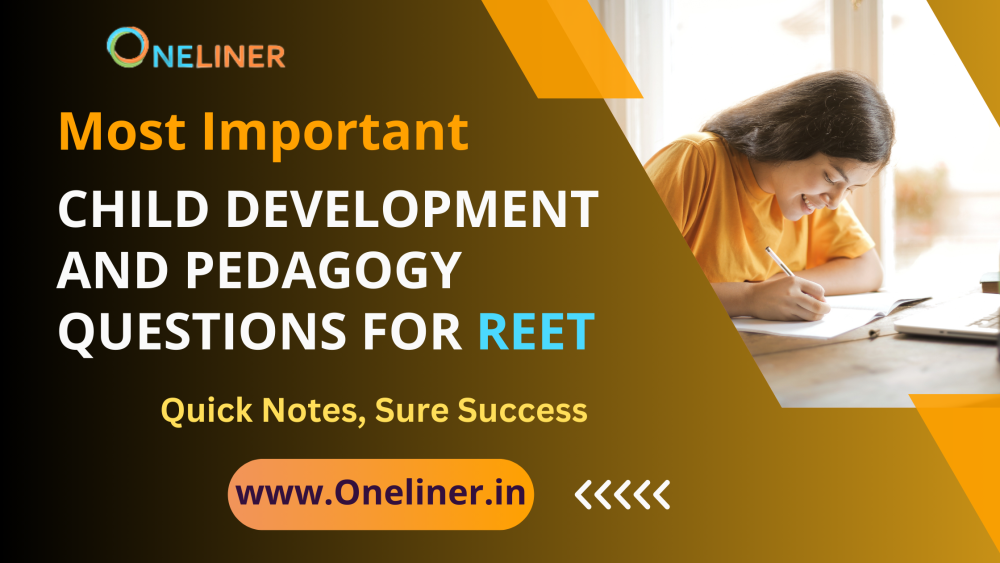 onelinerinfo@gmail.com
onelinerinfo@gmail.com
Home | About Us | Contact Us
Home | About Us | Contact Us

The Board of Secondary Education, Rajasthan conducts Rajasthan Teacher Eligibility Test (RTET). The State level RTET exam is conducted for the recruitment of Level 1 or Primary Teachers and Level 2 or Upper Primary Teachers.
Child development & pedagogy (CDP) is very important section in this exam. Here we listed some important child development & pedagogy questions and answers for REET exam.
|
Q 1.
Which kind of research is done by the principal of school to identify the causes of various emotional problems of the students ?
Ans.
Action Research
|
|
Q 2.
What is the minimum number of hours of work per week of a teacher have according to Right to Education Act, 2009 ?
Ans.
45
|
|
Q 3.
What effort should a teacher make for the upliftment of Gifted children ?
Ans.
Special classes and motivation
|
|
Q 4.
Which psychologist first created the intelligence test ?
Ans.
Binet
|
|
Q 5.
According to Vygotsky, children learn by ?
Ans.
By interacting with adults and peers
|
|
Q 6.
Raven Progressive Matrices are used to measure ?
Ans.
Intelligence
|
|
Q 7.
Child Centred pedagogy means ?
Ans.
Giving importance to children's voices and their active participation
|
|
Q 8.
Which leads to creativity ?
Ans.
Divergent Thinking
|
|
Q 9.
Thematic Apperception Test (TAT) of measuring perception is a ?
Ans.
Projective techniques
|
|
Q 10.
Problem Solving is not ?
Ans.
About musical ability
|
|
Q 11.
Inclusion of children with special needs ?
Ans.
Requires a change in attitude, content and approach to learning
|
|
Q 12.
One main Characteristic of a Gifted learner ?
Ans.
He can feel understimulated and bored if the class activities are not challenging enough
|
|
Q 13.
Who gave 16 P.F. questionnaire to assess personality ?
Ans.
R.B. cattell
|
|
Q 14.
Which is not a psycho-motor activities of a child ?
Ans.
Thinking
|
|
Q 15.
Which is not a component of intelligence ?
Ans.
Vocational choices
|
|
Q 16.
Develpoment is never ending process, this idea is associated with which principle ?
Ans.
Principle of conntinuity
|
|
Q 17.
The aim of adding Art Education in N.C.F. 2005 is ?
Ans.
To appreciate cultural heritage
|
|
Q 18.
Which step makes research, action research ?
Ans.
Programme implementation and evaluation
|
|
Q 19.
Which has been ignored in children's Free and Compulsory Education Rights Act, 2009 ?
Ans.
Arrangement of education after 14 years
|
|
Q 20.
The Classical conditioning theory of learning was profounded by ?
Ans.
Pavlov
|
|
Q 21.
If the actual age of achild is 13 years and mental age is 14 years, then what will be the intelligence quotient ?
Ans.
107.69
|
|
Q 22.
When a problem has more than one probable solution and the thinking process which create those probable solution for the problem is called ?
Ans.
Divergent Thinking
|
|
Q 23.
To concretise the abstract concepts in a slow learners classroom the best method for a teacher is ?
Ans.
Demonstration method
|
|
Q 24.
There is an equivalent word in Latin (To mould) ?
Ans.
Educare
|
|
Q 25.
"Technology has led to an explosion of knowledge." What does this mean ?
Ans.
Growth and expansion at high speed
|
|
Q 26.
In arts- infused classrooms, students can be more productively active, physically as well as mentally because ?
Ans.
The arts offer additional learning modes
|
|
Q 27.
What is the meaning of the Latin verb "Adolescere "?
Ans.
To grow to become mature
|
|
Q 28.
Developing national parks and wildlife sanctuaries in relatively undisturbed areas is an outcome of which values ?
Ans.
Aesthetic values
|
|
Q 29.
Why gardening with kids in school helps learning ?
Ans.
It addresses multiple learning styles
|
|
Q 30.
"The increasing amount of time children in the age group of eight or nine are now spending on screens means they have shorter attention spans." What do you suggests for the development of children in schools ?
Ans.
Introduce yoga and mindfulness classes either as part of the PE curriculum or as optional lunch time or after school activity
|